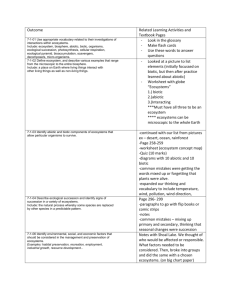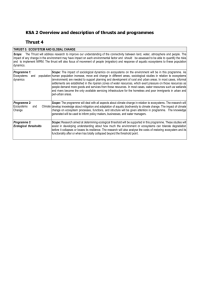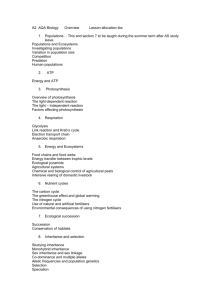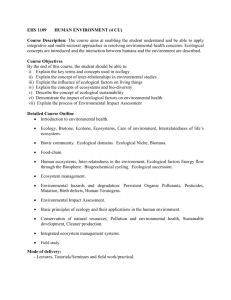Ecosytems Outcomes
advertisement
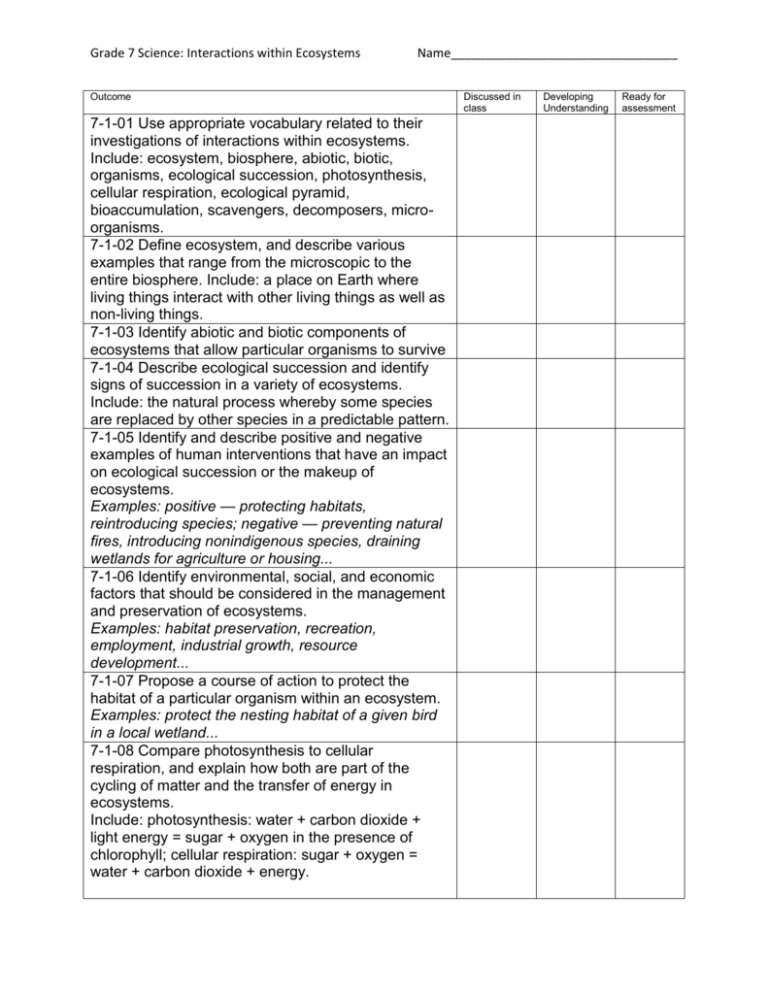
Grade 7 Science: Interactions within Ecosystems Name_________________________________ Outcome 7-1-01 Use appropriate vocabulary related to their investigations of interactions within ecosystems. Include: ecosystem, biosphere, abiotic, biotic, organisms, ecological succession, photosynthesis, cellular respiration, ecological pyramid, bioaccumulation, scavengers, decomposers, microorganisms. 7-1-02 Define ecosystem, and describe various examples that range from the microscopic to the entire biosphere. Include: a place on Earth where living things interact with other living things as well as non-living things. 7-1-03 Identify abiotic and biotic components of ecosystems that allow particular organisms to survive 7-1-04 Describe ecological succession and identify signs of succession in a variety of ecosystems. Include: the natural process whereby some species are replaced by other species in a predictable pattern. 7-1-05 Identify and describe positive and negative examples of human interventions that have an impact on ecological succession or the makeup of ecosystems. Examples: positive — protecting habitats, reintroducing species; negative — preventing natural fires, introducing nonindigenous species, draining wetlands for agriculture or housing... 7-1-06 Identify environmental, social, and economic factors that should be considered in the management and preservation of ecosystems. Examples: habitat preservation, recreation, employment, industrial growth, resource development... 7-1-07 Propose a course of action to protect the habitat of a particular organism within an ecosystem. Examples: protect the nesting habitat of a given bird in a local wetland... 7-1-08 Compare photosynthesis to cellular respiration, and explain how both are part of the cycling of matter and the transfer of energy in ecosystems. Include: photosynthesis: water + carbon dioxide + light energy = sugar + oxygen in the presence of chlorophyll; cellular respiration: sugar + oxygen = water + carbon dioxide + energy. Discussed in class Developing Understanding Ready for assessment Grade 7 Science: Interactions within Ecosystems Name_________________________________ Outcome 7-1-09 Analyze food webs, using ecological pyramids, to show energy gained or lost at various consumer levels. Include: producers; primary, secondary, and tertiary consumers 7-1-10 Analyze, using ecological pyramids, the implications of the loss of producers and consumers to the transfer of energy within an ecosystem 7-1-11 Explain, using ecological pyramids, the potential for bioaccumulation within an ecosystem. 7-1-12 Provide examples of scavengers and decomposers, and describe their role in cycling matter in an ecosystem. Include: micro-organisms. 7-1-13 Demonstrate proper use and care of the microscope to observe micro-organisms. Include: preparing wet mounts beginning with the least powerful lens; focussing; drawing specimens; indicating magnification 7-1-14 Identify beneficial and harmful roles played by microorganisms. Examples: beneficial — aid in digestion, composting, food and vaccine production; harmful — cause disease, food spoilage... 7-1-15 Research and describe human food production or preservation techniques that apply knowledge of micro-organisms. Examples: bread and yogourt making, food drying, sterilization, refrigeration... Discussed in class Developing Understanding Ready for assessment



